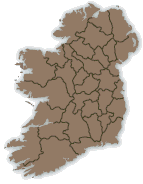Maidin, meán lae agus tráthnóna - Tomás Mac Con Iomaire (c.1916-?)
Recording: [Download audio file]
[Download AIFF audio file (of processed ‘user’ version)]
[Download AIFF audio file (of archive version)]
Transcript
Bhí fear fadó ann. Agus phós sé. Agus ní raibh aige ach triúr clainne. Agus cailleadh an t-athair agus an mháthair. Agus aon oíche amháin d'imigh an triúr deartháir leothub. Agus chonaic siad solas i bhfad uathub agus (ní i ngar dhóib). Agus rinne siad ar an solas. Agus céard a bheadh ann ach teachín beag. Agus ar maidin lá arna mháireach chuaigh beirt deartháir acub amach ag foghléireacht agus d'fhan (duine amháin) istigh ag réiteach dinnéir dhóib. Agus nuair a bhí sé ag tarraingt ar am dinnéir thug sé isteach caora dhon fheilm agus mharaigh sé í. Agus sceáin sé í. Agus chuir sé síos í. Agus ní rabh ann ach go rabh sí thíos nuair a tháinig fearín beag isteach. Dhá throigh ar leithead, dhá throigh ar fad agus dhá throigh dhéag féasóige.
"Cén chaoi a bhfuair tú (...) (féin)," a deir sé, "ghoil i leith mo theach, is ag tabhairt isteach caora dhon fheilm agus í a mharú? Agus (...) isteach agus (...) agus caora dhuitse (...) tráthnóna?"
Rugadar ar a chéile, lámh in íochtar, lámh in uachtar, lámh (...). Is gearr go bhfuair an tráthnóna an ceann ab fhearr air. Rug sé amach é i (gcoill). Agus rug sé leis tua. Agus bhuail sé buille ar chrann ann. Agus rinne sé scoilt insa gcrann. Agus chuir sé síos féasóig an fhir bheag ann. Agus chas sé timpeall an chrainn é. Agus nu-... (Ansin nuair a) thiocfadh an beirt deartháir abhaile theaspáinfeadh sé an gníomh a bhí déanta ó d'imíodar go dtáinig siad.
Translation
Long ago there was a man. And he got married. And he only had three children. And the father and mother died. And one night the three brothers went off. And they saw a light at a great distance from them and not close to them (?). And they went towards the light. And what would it be only a small little house. And the next morning two of the brothers went out hunting and one stayed inside preparing dinner for them. And when it was nearing dinner time he brought in a sheep from the farm and he killed it. And he cut it up. And he put it down. And he had only just put it down when a small little man came in. Two feet wide, two feet tall and twelve feet of beard.
"How did you (...) yourself," he said, "to go into my house, and bring in a sheep from the farm and kill it? And (...) in and (...) and a sheep for you (...) this evening?"
They caught each other, a hand below, a hand above, a hand (...). It wasn't long before the evening got the better of him. He brought him out into a wood. And he brought an axe with him. And he hit a tree there. And he split the tree. And he put the small man's beard into it. And he turned him around the tree. And whe-... Then when the two brothers would come home he would show them the deed he had done since they left until they returned.
Commentary
This is a version of an international folktale, ATU 1159 The ogre caught in the cleft. There are many variants of the story, but all contain the central element of a beard or fingers being caught in a vice or cleft. The tale is known all over Europe, throughout northern Russia and as far east as Japan. See Hans Jorg Uther, The types of international folktales: a classification and bibliography (3 vols, Helsinki, 2004). The story was known in county Galway, but is generally very rare in Ireland. Only three examples were recorded in Seán Ó Súilleabháin and Rieder Th. Christiansen's The types of the Irish folktale (Helsinki, 1968), under the title AT 1159 The ogre wants to learn to play. It contains an international folk motif, K1111.1 Ogre’s (dwarf’s) beard caught fast. See Stith Thompson, Motif-index of folk literature (rev. and enlarged ed., 6 vols, Bloomington, Ind., 1955-8).
Title in English: Morning, noon and eve
Digital version published by: Doegen Records Web Project, Royal Irish Academy
Description of the Recording:
Speaker:
Tomás
Mac Con Iomaire (c.1916-?) from Co. Galway
Person who made the recording:
Karl Tempel
Organizer and administrator of the recording scheme: The Royal Irish Academy
In collaboration with: Lautabteilung, Preußische Staatsbibliothek (now Lautarchiv,
Humboldt-Universität zu Berlin)
Recorded on 20-09-1930 at 15:30:00 in
University College, Galway. Recorded on 20-09-1930 at 15:30:00 in
University College, Galway.
Archive recording (ID LA_1173g1, from a shellac disk stored in
Galway) is 01:36 minutes long. Archive recording (ID LA_1173g1, from a shellac disk stored in
Galway) is 01:36 minutes long.
Second archive recording (ID LA_1173dd1, from a shellac disc stored
at the Royal Irish Academy) is 01:37 minutes
long. Second archive recording (ID LA_1173dd1, from a shellac disc stored
at the Royal Irish Academy) is 01:37 minutes
long.
User recording (ID LA_1173g1, from a shellac disk stored in Galway)
is 01:34 minutes long. User recording (ID LA_1173g1, from a shellac disk stored in Galway)
is 01:34 minutes long.





